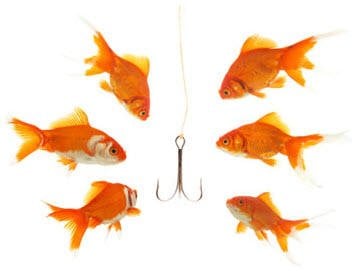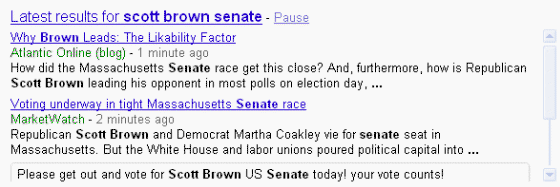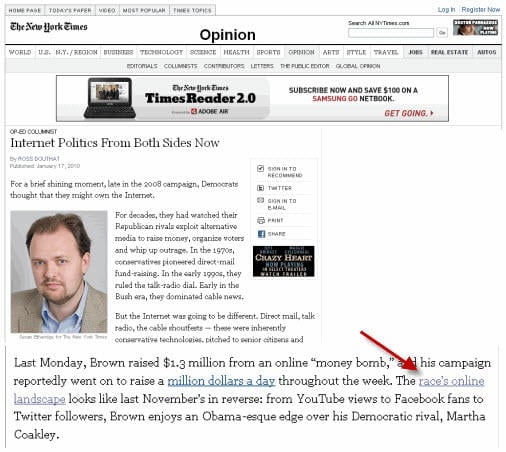
Recently at WordStream, we launched our first link bait campaign. By our standards, the campaign was successful, and we thought we’d share the details on how to build a linkbait campaign.
How to Get Links from New York Times: A Case Study
In a nutshell, we attribute the campaign’s success to setting clear objectives, creating killer content and aggressive marketing. What resulted from our hard work, planning and execution was a link from one of the most trusted sources on the planet: The New York Times.
Case Study Contents:
How did we do it? Read on and find out how to get a link from the New York Times.
Link Bait Campaign Intro: Before You Start, Have a Plan!
You may be wondering how to start link baiting, and in ultimately, great linkbaiting is all about planning. In my mind, much of link baiting fails because it lacks planning. Bloggers and link builders think that if they throw up a piece of content it will magically go viral…on its own…eventually…because it’s just “so damn good” that people will be compelled to share it with others. This rarely happens. To succeed at link baiting, like any other marketing activity, you must follow a plan.
Before embarking on our link bait campaign, we developed a detailed plan, which included:
- Establish goals: What are our objectives? How do we define success?
- Create content: Pick a hook and create a killer piece of content
- Promote aggressively: Pick targets and conduct an all-out media and social networking blitz
- Track progress: Use tools to measure external coverage, link acquisition, traffic, leads, all Web activity tied directly to the campaign
- Evaluate results: Did we achieve our goals? If not, then why?
Link bait planning is key to having a winning link-bait campaign, so be sure to spend a solid chunk of time on brainstorming and planning. All link bait strategies need a good plan.
Setting Goals for a Linkbait: Goals of Our Link Bait Campaign
So like I said, it’s critical to create a plan ahead of time, which includes clearly defined goals. By establishing your goals, you give your link-bait campaign structure and direction. Also, having goals helps determine which type of link bait “hook” to create, be it content, a puzzle, contests, widgets, humor or news, etc.
Now, the obvious goal of link baiting is to get links…copious amounts of links with a few gems (high trust, high authority links). But, in my opinion, your goal targeting shouldn’t end there. The perfect linkbait campaigns result in a trifecta of increased:
- Links
- Traffic
- Leads/Sales
Now, you don’t need to hit all three targets for your campaign to succeed. In fact, if your goal is simply to get one high value link, that’s fine. But what IS important is that you establish this ahead of time, so you can judge success, evaluate your efforts to measure ROI and to inform future efforts.
We spent some time assessing the goals of our link bait campaign. For our campaign, the primary success metric was links, with the prize being one link from a national publication. We also hoped to drive traffic, more referred and organic. The traffic is essential to producing the links. If nobody sees your bait, nobody shares it. With regard to leads and sales, our link bait wasn’t relevant to our products, so we doubted we’d generate many sales from the traffic. But our objectives were links and traffic. So if we produced leads, that would be a nice bonus.
Creating the Link Bait
Okay, so let’s establish another point: the content is the most important element of link baiting. It’s the “bait” in the link bait. Don’t waste time trying to figure out what the latest new type of linkbait is or use cheap tricks – it’s all about content. Poor content does not get shared, does not go viral, does not attract links. So given how important content is to your campaign’s success, it’s critical you devote the bulk of your time, energy and resources to developing your “bait.”
Great link bait can come in many different forms, but here are some link bait ideas to get you started:
- Infographic
- News Piece
- Video
- Controversial Topic
- Quiz
- Poll
- Interview
While these are some great link bait examples, feel free to think outside the box.
Since our primary goal was to earn a link from a national publication, we created link bait with a “news hook,” i.e. content that would leverage hot and trending topics and tap into public passion. Larry Kim created an article that claimed Scott Brown would win the Senate race based on social media popularity metrics. This was a stroke of genius because the nation was buzzing about the upcoming Senate race and we felt we could ride that wave of media frenzy. In addition, Larry leveraged “social media,” another trendy topic, perfect for link baiting social news. This combination of two hot topics was the perfect storm, as it appealed to both fans of the impending Senate race and social media enthusiasts too.
Link Bait Promotion
For your link baiting to be effective, you must be willing to promote the living crap out of it. Even great content and the best link bait doesn’t go viral on its own. It often needs help. For our marketing campaign, we knew we’d have to employ a super-aggressive promotional strategy to propel our content to viral status, so we devoted three hours to an all out media blitz that included:
Press Release for Linkbait: $140 through Marketwire
- Within minutes of launching the press release, it ranked #1 for the query “Scott Brown” and an array of other Brown-related queries in the Universal Search Engine Results (SERP). Even better, the press release remained #1 in the Universal SERPs for eight hours.
Organic Ranking: With little effort, the link bait blog post itself ranked first page for numerous “Scott Brown,” “Massachusetts Senate Race,” and “Martha Coakley” related queries, driving a bunch of organic traffic, which helped drive awareness and additional coverage
Real Time Search: Google’s Real Time Search generates fresh and continuous feeds from video, news, blogs, forums and Twitter, making it a great “live listening tool.” I can’t stress how beneficial real time feeds were to our campaign strategy. Because of the Massachusetts Senate Race “hotness of topic,” the real time search results were buzzing with activity. This gave us the ability to monitor a live feed for Scott Brown news and discussion, which was key to discovering fresh content to target for outreach and “strategic commenting” (discussed next).
Strategic Seeding: So I mentioned how Google’s Real Time Search was integral to our promotion. That’s because it fed us a constant stream of new content for strategic seeding opportunities. We used Real Time to target popular, heavily trafficked, online publications, where we dropped in compelling comments with a link back to our “bait.” To ensure our comments wouldn’t get buried/paginated, we had to comment within minutes of the target content being published. That’s why real time search was key to our efforts. In the first few hours of our campaign, these strategic comment links drove thousands of visits and created more awareness for our link bait.
Social Media: How to Gain Strong Referral Traffic from Social Websites – a Simple Linkbait Tactic
Twitter was also instrumental for us, allowing our content to reach people instantly and increase share-ability. Our strategies for Twitter included:
- Target key players: We tweeted @ the Scott Brown campaign, his daughter’s, and other rabid supporters found using Twitter Search.
- Reach out to media: We tweeted @ influential journalists from this list: Tweeting Journalists. In hindsight, this “spray and pray” approach may have been too spammy. It could have been more effective if we’d made the extra effort to reach out to journalists individually, with personal tweets. But this was an experiment, so it’s good intelligence for our next campaign.
- Hashtags: We incorporated the trending Senate Race hashtags (like #41st and #masen) in our Tweets for additional awareness.
- Twitter bots: These profiles scraped and tweeted the press release and our link bait tweets, producing a flood of Twitter activity and traffic to our website.
- Retweets multiplier effect: A lot of ardent Brown fans retweeted our bait to support their paradigm that Brown would win, while Coakley supporters retweeted criticisms of the post. Either way, bad or good, it contributed to the viral component.
In addition to link baiting social news with Twitter, we hit other popular social media platforms, including:
- YouTube: Dropping comments in new Scott Brown and Martha Coakley videos
- Digg
- StumbleUpon
- Ping.fm: Simultaneouslyblasting additional social sites
Rippling Coverage: The combination of blog comment dropping, social media buzz and media activity produced a ripple effect of coverage from others in the blogosphere we hadn’t targeted directly, who referenced our social media poll (polls as link bait work great) in their articles, leading to even more interest, traffic and links.
Follow Ups: We reached out to journalists and bloggers who covered our article and thanked them. Now, this wasn’t part of the campaign, per say, but more of a courtesy and common sense, as it aids in future outreach and relationship building with these influencers.
While promoting your link bait campaign may seem like a lot of work, it’s absolutely essential. Even the best linkbait articles of all time used heavy promotion to make their link bait campaign a success.
Link Bait Campaign Results
So our link bait campaign was a success. We achieved our goal and got an editorial link in the New York Times.
We also scored a bonus editorial link from Politico. So that’s two links from major online news publications, doubling our goal expectations for the link bait. The full-on media blitz we embarked on also spawned mentions and links from across the Web and world, like here in Sweden. In addition, people dropped unsolicited comments and links to our social media poll in message boards, forums and media posts as the viral nature of our campaign caught fire. The link bait also sparked a number of copycat Senate Race social polls too, which was flattering.
Goal Breakdown
- Links: 236 total links, including references in high profile, major trust sites New York Times and Politico
- Referral traffic: Referred traffic quadrupled on our site, with thousands of pageviews in hours
- Leads/Sales: 3 leads
Now, the traffic the link bait drove wasn’t relevant to our core product (we’re a search marketing software provider), so we only converted a handful of people. However, we did achieve our primary objective by getting a link from a highly trusted media outlet. In the future, we’ll use the same approach but try to tailor our “hook” to a more relevant audience.
So Why Was Our Campaign a Success?
Establishing a clear and detailed plan from the outset and executing it effectively was critical to success. Marketing our content aggressively was also paramount. But without the linkability of the content, our campaign would’ve fallen flat on its face.
So what was it about our content that made it so darn linkable?
- Playing on emotion: Our social media survey caught fire because people nationwide had strong opinions about the Massachusetts Senate Race. This was a high-stakes event that meant a great deal to both parties. GOPs loved it because it reinforced their position. Dems panned it as utter nonsense. Either way, it was a winner for us.
- Timing: The national spotlight on the Massachusetts Senate Race (and Scott Brown) peaked around the time of link bait piece, so timing was everything. The bait wouldn’t have gotten nearly the amount of coverage had we released it any earlier. We hit the sweet spot, which was huge.
- Hot and trendy: Scott Brown emerged into a political phenomenon leading up to election. The media was looking for anything they could get their hands on about Brown, so our link bait enjoyed the benefits of a hungry audience.
- Creative thinking: This post would never have gone viral were it not for the unique angle of the link bait. Had Larry written an article about how Scott Brown should win because Dems are destroying the country with their Socialist agenda, etc, it wouldn’t have had the same appeal. But by combining two hot topics: social media and Scott Brown, we struck gold. So creativity and originality were key as well.
Keep this in mind for future link bait ideas. Controversy that plays on emotion, a well-timed piece, trendy news, and a creative piece are all perfect linkbait examples. Even better if you can combine all of them.
Congratulations! You now know how to create a linkbait campaign – and an awesome one at that! As newly inducted linkbait campaign experts, we wish you the best of luck. Now go forth and linkbait – we got a link from New York Times and you can too.












